|
 Propagation
Propagation
This page is about:
Fertilization|Determining
the sex|Dispersal
agents|Growing
a Ginkgo from seed|Emails
from readers
+ videos
The Ginkgo is a gymnosperm, meaning "naked seed", because the seed is not enclosed in a ripened fruit as in flowering plants (angiosperms), but is protected by cones or a fleshy seed coat. Its propagation is unique. Pollination and the development of the sexual phase occur in the first year (April to September in the northern hemisphere). Research indicates that the embryo is well-developed at the time of dispersal and that the seed coat only contributes to winter dormancy. After shedding of the seeds the embryo carries on developing according to external temperature: the higher the temperature, the faster the development.
The Ginkgo is (like some conifers and cycads) dioecious, each spring pollen and ovules are produced on separate trees on the short branches among the bases of the young leaves, for the first time after 20-35 years. Occasionally both genders are found on the same tree. It's a dicot. The female tree must be growing in the presence of a male tree to be fertilized. Ginkgo and the cycads are the only living seed-producing plants (spermatophytes) that have motile or free swimming sperm (more info here). The Ginkgo has a unique place because it is the sole living link between the lower and higher plants, between ferns and conifers. This was discovered on September 9, 1896 by Sakugoro Hirase. He found swimming sperms in the seeds of a female tree in the Botanical garden Todaifuzoku in Tokyo. Read more about Hirase on my History-page.
The yellow pollen
cones (3-6 on a shoot) on the male
tree are hanging looking like catkins, each
about 1.2-2.2 cm. On the main axis numerous appendages are attached. The
pollen grains are boat-shaped with widely gaping slit. Each bears mostly
two pollen sacs (microsporangia) at the tip containing the sperm cells.
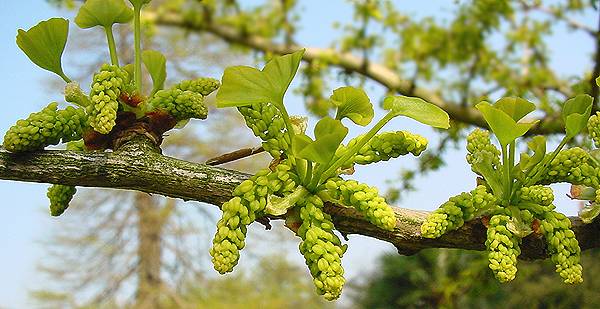
male pollen |
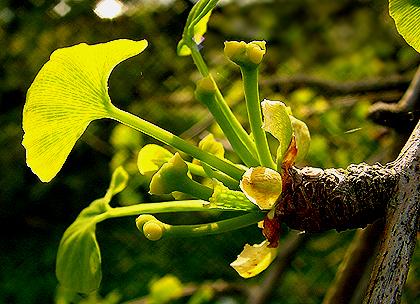 |
videos female ovules
|
ovules in April |
ovules in June |
Sometimes the seeds and
pollen grow on leaves without stalkes (oha-tsuki = 'attached to leaves'
in Japanese), mostly on older trees. These trees also have 'normal' seeds/pollen
growing. They are often designated as 'living national treasures' in Japan
because of their rarity and specialness (photos here
and on my Tree-page).
There is an abundance of seeds
on one tree.
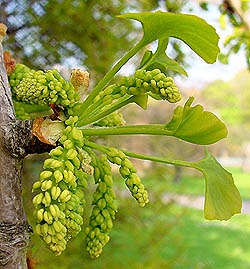 Pollen on Ginkgo.
|
An ovule consists
of one integument (the future seed coat) that surrounds a tissue called
the nucellus. In this nucellus four megaspore cells are formed. At this
time the pollens are released from the pollen sacs of male trees (April-May),
they are carried by the wind to the female trees (distance unknown) and
land upon a pollination droplet, which is present on the micropyle at the
tip of the integument.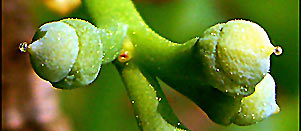 The
drop retracts in the tiny opening and brings the pollen grains into a pollen
chamber in the nucellus, where they develop into much branched
pollen tubes (gametophytes). One of the cells in the ovule then enlarges,
free nuclear divisions follow, cell walls begin to form after that and
then two bundles extend throughout the innermost region of the integument,
consisting of neck cells and a large egg cell. In the meantime a column
of female gametophyte tissue - known as the "tent pole" - elevates between
two archegonia and extends towards the pollen chamber. The
drop retracts in the tiny opening and brings the pollen grains into a pollen
chamber in the nucellus, where they develop into much branched
pollen tubes (gametophytes). One of the cells in the ovule then enlarges,
free nuclear divisions follow, cell walls begin to form after that and
then two bundles extend throughout the innermost region of the integument,
consisting of neck cells and a large egg cell. In the meantime a column
of female gametophyte tissue - known as the "tent pole" - elevates between
two archegonia and extends towards the pollen chamber. |
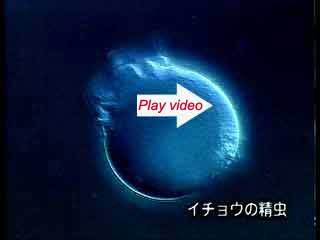
Video : ovules and spermatozoid of Ginkgo biloba |
During the months
following pollination, the pollen grows big enough to form two motile
sperms in the pollen chamber.
Sakugoro Hirase observed swimming sperm (motile spermatozoids) for the first time in the seeds of a female Ginkgo tree growing in the Botanical Garden of the University of Tokyo in Japan in 1896.
|
The basal end of a male gametophyte
is suspended in a cavity above the female gematophyte (called the fertilization
chamber).
This female gametophyte in the
ovule is then green-coloured, filled with starch grains and is unique among
seed plants in containing chlorophyll and photosynthesizes. In the pollen
tubes the sperm cell of a male gametophyte divides, producing two sperms,
each having thousands of flagellae. The actual
fertilization
takes placein
fall. The pollen chamber and the space around the tentpole unite into a
bigger archegonial chamber filled with fluid. The sperms and the contents
of the pollen tubes are then released by a rupture of the basal end of
the gametophyte (because of its swelling) and swim upwards (the micropyle
faces downwards in fall!) into the fertilization chamber filled with fluid
(an inner sea). The sperms swim shortly in the liquid and then one of them
fuses with the egg nucleus.
Click here
for
schemes, photos and videos of the ovule development.![]()
The sperm of the Ginkgo has many
similarities with that of the Cycad.
Begin September the ovules are
still green-coloured.
Shortly after fertilization
the growth of the embryo
begins, the ovules enlarge tremendously looking like plumlike seeds about
2.5 cm (1 inch) long and this continues after the seeds fall to the ground.
The actual fertilization most likely occurs on the tree between 130 and
140 days after pollination.. The embryo grows into the nutritive tissue
of the female fertilization chamber (gametophyte). There are 2 cotyledons.
|
The seeds fall off the parent tree in fall after the leaves. They are relatively large in comparison to the seeds of most other trees (esp. conifers). A seed at maturity consists of an embryo = endotesta (sometimes 2 or more), nutritive tissue and the seed coat, which is made up of a hard inner layer (sclerotesta with 1 sometimes 3 ribs) and a fleshy, yellow to orange-coloured outer layer = sarcotesta (5-6 mm thick). This outer layer becomes mottled, purplish green and rancid smelling when ripe. |
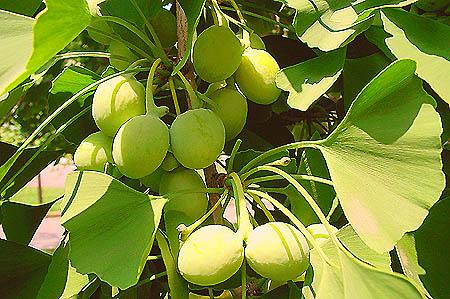 |
Because of the presence of butyric
acid, the fleshy layer produces an odour similar to rancid butter upon
decay. Its tissues may cause nausea or skin eruptions (dermatitis) in man.
The inner tissues are palatable (gametophyte and embryo). The seed coat
also contains small amounts of urushiol, an allergen that only on
contact with the skin is responsible for poison oak and poison ivy contact
dermatitis in sensitive people so when gathering the ripe fruits wear rubber
gloves. Squeeze out the seeds in a bucket of water, wash them thoroughly
and then dry them. After that they look like a large unsplit pistachio
nut. (female trees seeds: more info here).
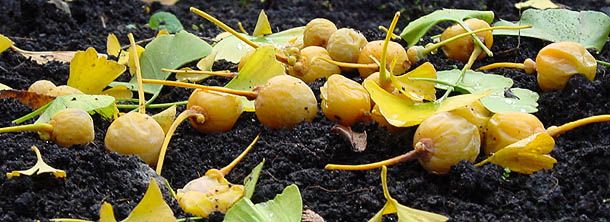 |
 |
|
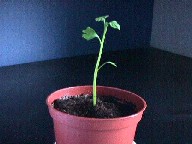 |
Ginkgo trees can also reproduce asexually: read the section about the chichi on my Tree-page about this.
The Ginkgo can also be propagated
by cuttings (best
way to be sure of the sex). Take young or half-ripe wood about 15 cm long
during May-July. Put these in a frame and keep moist. They usually
start growing best in their second year. You may also take cuttings of
mature wood of the current year's growth. Shoots about 15-30 cm long are
taken in December and placed in a frame. They should root in the spring.
More information about treating
the cuttings via the propagation-links on my Links-page.
Grafting: Grafting is often used by nurseries to grow new Ginkgos. Also branches of male trees are grafted onto female trees in order to fertilize them or visa versa; the female trees often produce very good seeds.
Vegetatively propagated Ginkgos seldom have a dominant central leader, because a lateral branch (rooted or grafted) will continue growing in the direction it had when still attached on the parent trunk. Therefore nurseries stimulate the production of vertical shoots by cutting back the trees.
Determining the sex| The Ginkgo is dioecious, male
and female trees are apart. Male/female seed sex ratio 1:1. The sex
chromosomes (XX females and XY males, just like humans) are difficult
to distinguish, so the tree's gender is not easily classified.
Mostly the only way to know the sex of the Ginkgo tree is to wait until the plants bloom. The DNA-sequence data for the Ginkgo is known however. Occasionally both genders are found on the same tree. Many trees at nurseries are grafted male trees (more info here). Buds are removed from male trees and grafted onto the rootstock of a seedling ginkgo, eventually becoming the top growth. |
|
The tree's gender is not easily
classified so some say it can be seen by the deepness of the cleft in the
leaves (female trees are said to have less deeper incised leaves). 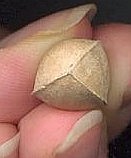 Others
say a young tree's gender can be seen on female trees which flower 2-3
weeks later than male trees and the female leaves fall later in fall. For
instance the old Ginkgo in Utrecht is male and the leaves of the female
branch turn yellow later in the season than those of the male tree where
the branch is grafted upon (click on photo left for enlargement to see
this female branch in fall).
Others
say a young tree's gender can be seen on female trees which flower 2-3
weeks later than male trees and the female leaves fall later in fall. For
instance the old Ginkgo in Utrecht is male and the leaves of the female
branch turn yellow later in the season than those of the male tree where
the branch is grafted upon (click on photo left for enlargement to see
this female branch in fall).  Also
the female tree tends to have almost horizontal branches. In Chinese literature
it is said that seeds marked with two ribs produce female trees and those
with three ribs male (although these are more rare). Also the seeds should
be sown in such a way that they face each other and those with three ribs
should be grown along a waterside...
Also
the female tree tends to have almost horizontal branches. In Chinese literature
it is said that seeds marked with two ribs produce female trees and those
with three ribs male (although these are more rare). Also the seeds should
be sown in such a way that they face each other and those with three ribs
should be grown along a waterside...
|
please visit my YouTube channel with many videos. |
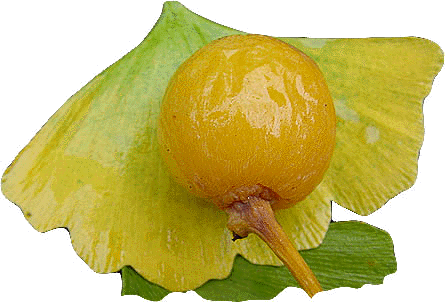 |
The scarified seeds
are then deposited in droppings, ready for immediate germination (time
of germination depending on the climate).
Dispersers in the times of the dinosaurs could have been the dinosaurs (probably carrion feeding scavengers), mammals and possibly birds. In the Paleogene two families of primitive Carnivora, the Viverravidae and the Miacidae are potential Ginkgo dispersers. They were relatively small, from the size of a weasel to that of a small cat. |
Nowadays different mammals feed
on and probably disperse the seeds: the red-bellied squirrel (Callosciurus
flavimanus var. ningpoensis) on Tianmu Mountain and the gray squirrel (Sciurus
carolinensis) in eastern North America. Also the possum according to an
emailer in Australia.
Also carnivores like the masked
palm civet (Paguma larvata) in Zhejiang Province, the leopard cat (Felis
bengalensis) in Hubei province, China and the raccoon dog ("hondo-tanuki"
= Nyctereutes procyonoides) in Japan. These carnivores eat whole
seeds and deposit intact nuts in their droppings, so maybe the smell of
the seedcoat attracts these animals because it resembles the smell of rotting
flesh.
Other dispersers are possibly
birds, for instance crows, and mice.
|
Time-lapse video germinating Ginkgo seeds. video on YouTube |
This dispersal allows the distribution
of the species and transport to some place where there may be less competition
for light or other resources.
A cache of seeds was found in a tree crotch about 50 m from the nearest source of the seeds, apparently done by birds. In North America seeds without the fleshy outer coat were found beneath various species of trees up to 150 m from the nearest seed-producing Ginkgo. |
 In
fall gather the seeds (wear latex gloves). Remove the fleshy coating (gloves!)
by placing the seeds in a jar of warm water, crush the coat and squeeze
the seed out with your fingers. Watch video (select HD-quality) below:
In
fall gather the seeds (wear latex gloves). Remove the fleshy coating (gloves!)
by placing the seeds in a jar of warm water, crush the coat and squeeze
the seed out with your fingers. Watch video (select HD-quality) below:
|
|
Then rinse the seeds
a few times (they must be really very clean!) and let them dry well.
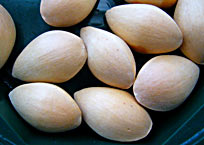 Seeds can also be bought from
seed companies, on the internet, nurseries etc. Try to buy from a reputable
firm which sells good quality seeds.
|
Stratification:
Although this is not strictly
necessary research has proven that germination is better if the seeds experience
some cold temperature for 2 months.
Scarification:
Chip the seeds with a sharp
knife or make a few swipes with a sharp edged file or use sandpaper to
allow moisture being more readily absorbed (imitating the stomach of seed
dispersers like the dinosaurs were). Then soak the seeds in cold or lukewarm
water for about 24 hours to soften the coat. Seeds that remain floating
will most likely not germinate so you can throw them away. Then
put the remaining non-floating seeds into a 10% bleach solution (water/bleach
9:1) for about 10 minutes to protect against fungus, rinse well 2
times after that. Dry them briefly between paper towels.
After my own research attempts
I ended up with these possible stratification methods:
| Put
3-5 seeds in 3 times the amount of moist sterile sand
(1 part water + 4 parts of sand) or
moistened kitchen towels or
slightly dampened vermiculite (or perlite)
or
moist peat. Moist
means no dripping when squeezing a handful or with kitchen towels no dripping
when holding at one corner. Moistening can also be combined with spraying
with a fungicide. Vermiculite is sterile, inexpensive and for sale in garden
centers etc.
Put this in a little container or small sealed polythene bag in the fridge (+ 50C). If you use kitchen towels place the seeds on one half, cover with the other half, put in matching thin polythene bag and close it. Mold growing on the towel is no problem, just get a new towel. Check twice a week for fungus and germination and turn them over. Germination time is 30-60 days, so start about 2 months before your spring begins with stratification. |
|
If you don't want to stratify
the procedure is the same, but then put the closed container or bag in
a light spot at room temperature (70-750F/21-240C).
Put in pots when a few leaves have grown.
| Sand method recommended
by me: I got 90% germination after 2-3 weeks with good quality clean seeds
at room temperature in little container after storing them for a few months
in the fridge and scarification after that; only slightly covered with
sand:
Seed germination after 3 weeks
from start: left sand-method/right kitchtentowel-method. Also watch video
below.
|
|
Video: seedlings of 10 days old |
Video: the same seedlings 18 days old |
After stratification move 3-5 seeds into 4-6" pots. The pots must be clean and have at least one drainage hole and best is pots with ribs or slits to get better rootforming. Use fresh soaked sandy potting soil (40% sand with some grit or perlite) (you may spray a fungicide again). Best is sandy loam that drains well. Sowing depth about 0,6"=1,5 cm. Cover lightly with sand. Don't compact, just tap the soil. Put in a cold frame or indoors in a light place, not full sun. Mist daily, water only when necessary. Keep the soil moist, not wet. After germination never let the roots dry out or stand in water. Take care of good air circulation. When the seedlings have grown enough put them outside (transplant in autumn into individual pots) in a shadowy position and fertilize (organic). Put in permanent position after about 2 years.
You may leave your Ginkgo permanently
in a pot and treat it more or less like a bonsai. Then you can grow a Ginkgo
even on your balcony! More about Ginkgo as a bonsai on
my Bonsai-page.
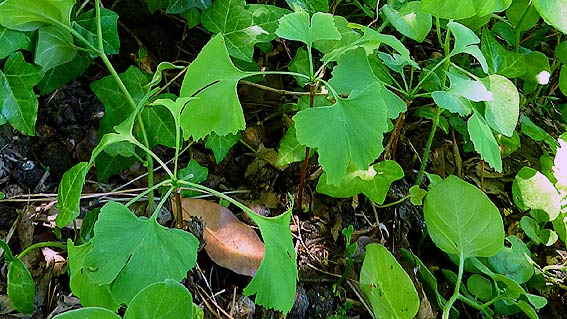 Sowing
outside:
Sowing
outside:
In fall sow preferably in a cold frame or unheated greenhouse. Put seeds 2-3" deep and cover with 2 inches of mulch or straw (in autumn), remove this in spring. Then cover the seeds lightly with sand, mulch etc. Best sowing time is March-May when there's longer daylight. Misting is better than watering. Watch out for squirrels, mice etc. Don't sow in the height of summer.
Ginkgo seeds have an irregular
germination. Low temperatures (between 2 and 10°C) following fertilization
hinder embryo development and delay the germination of outdoor-sown seed
until the following spring or summer.
The length of time between pollination
and germination under field conditions can vary between 12 and 14 months,
depending on local weather conditions.
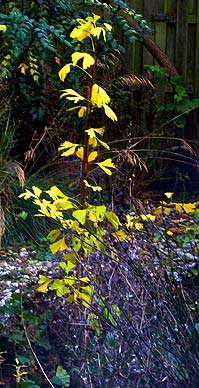
Ginkgo seedling in garden |
From an emailer in Japan I got this idea: to get uniform germination bury the seeds 30 cm in autumn, dig them out in spring and sow them. More information about planting can be read on my page about the tree. Please email me your sowing results and ideas! Below you can read some reactions of readers. |
|
please visit my YouTube channel with many videos. |
 |
| The Ginkgo is listed in the IUCN Red List of Endangered Plants. Although it is cultivated and planted by humans, it is endangered, and at risk for loss of biodiversity because of propagation by cuttings rather than by seed, due to human preference for male trees. |
![]() This
is the first year I've really cleaned seeds (250+). The smell wasn't as
bad as expected, but still bad enough. However, I cleaned the seeds in
Sodium Carbonate or washing soda 2 table spoons/1gal water (60ml/4L). Which
wipe out about 90% of the smell. I figure that since the smell is caused
by acids why not just nutralize the acid with a base and get rid of the
smell. It seemed to work. Also, Sodium Bicarbonate which is baking soda
should work as well. It's a little weaker though and maybe you should double
the rate. I should also note that both of these chemicals are both fungices
and very safe to use. You can eat baking soda. My procedure for cleaning
is listed below.
This
is the first year I've really cleaned seeds (250+). The smell wasn't as
bad as expected, but still bad enough. However, I cleaned the seeds in
Sodium Carbonate or washing soda 2 table spoons/1gal water (60ml/4L). Which
wipe out about 90% of the smell. I figure that since the smell is caused
by acids why not just nutralize the acid with a base and get rid of the
smell. It seemed to work. Also, Sodium Bicarbonate which is baking soda
should work as well. It's a little weaker though and maybe you should double
the rate. I should also note that both of these chemicals are both fungices
and very safe to use. You can eat baking soda. My procedure for cleaning
is listed below.
1. place everything in a large
bucket with washing soda mixture.
2. remove seeds from pulp with
hands and place seeds in 8 " plastic flower pot (dump pulp in a safe area).
3. Rince seeds under running
water for about 5 minute swirling the seeds around to remove the rest of
the pulp.
4. 5 minute dip in fresh washing
soda mixture.
![]() My
method with most all tree seeds is to keep them in the kitchen refrigerator
in a plastic bag of moist sphagnum moss over the winter. That worked
well with Ginkgo seeds. By spring, some of them were already germinating
in the bag.
My
method with most all tree seeds is to keep them in the kitchen refrigerator
in a plastic bag of moist sphagnum moss over the winter. That worked
well with Ginkgo seeds. By spring, some of them were already germinating
in the bag.
![]() I
use peat/perlite mix: take the peat and put it in a container, then pour
boiling water over it. This will get the peat to absorb water and
it will kill any fungus spores present. Add the water slowly as to not
overwet the mix. Then, once it is cool enough to mix, add perlite. I usually
go for a 1:1 mix. You could just as easily go 2:1. Mix it up, and take
a handful, make sure you don't get water dripping down your arm when you
hold it. Take a couple handfulls, put them in a ziplock bag, add 3-5 seeds,
seal, shake it a bit so the seeds are in the mix. Within a week or
2, the first seedlings will appear. Pot them up as soon as possible, and
then reseal the bag and wait for more. Always has worked well for me.
I
use peat/perlite mix: take the peat and put it in a container, then pour
boiling water over it. This will get the peat to absorb water and
it will kill any fungus spores present. Add the water slowly as to not
overwet the mix. Then, once it is cool enough to mix, add perlite. I usually
go for a 1:1 mix. You could just as easily go 2:1. Mix it up, and take
a handful, make sure you don't get water dripping down your arm when you
hold it. Take a couple handfulls, put them in a ziplock bag, add 3-5 seeds,
seal, shake it a bit so the seeds are in the mix. Within a week or
2, the first seedlings will appear. Pot them up as soon as possible, and
then reseal the bag and wait for more. Always has worked well for me.
![]() I
collected some seeds and started growing them about 3-4 months back.
After carefully reading Cor's directions of course! For a little more than
a month, the seeds did nothing. Nothing happened. I thought I had killed
them all even though I followed the directions. One day, I woke up and
found one little seed have cracked and a tiny root was sticking out! That
was so exciting! Since that first seed sprouted, quite a few have followed.
That first seedling is about 10 centimeters tall now. And I have 13 more
that are growing up everyday. My dream is to plant a Ginkgo forest.
I
collected some seeds and started growing them about 3-4 months back.
After carefully reading Cor's directions of course! For a little more than
a month, the seeds did nothing. Nothing happened. I thought I had killed
them all even though I followed the directions. One day, I woke up and
found one little seed have cracked and a tiny root was sticking out! That
was so exciting! Since that first seed sprouted, quite a few have followed.
That first seedling is about 10 centimeters tall now. And I have 13 more
that are growing up everyday. My dream is to plant a Ginkgo forest.
![]() About
100 Ginkgo seeds were planted in milk cartoons in the Ottawa area, Canada,
outside under a protective screen of chicken wire. I watered these regularly
and 90-95% have germinated. (source: Truscott).
About
100 Ginkgo seeds were planted in milk cartoons in the Ottawa area, Canada,
outside under a protective screen of chicken wire. I watered these regularly
and 90-95% have germinated. (source: Truscott).
![]() I
soak the seeds 2-3 days in water and then put them in a tray on a layer
of sand. Then I cover them lightly with sand. I put the tray on a warm
and light spot. I check the sand each day and if necessary moisten it again.
I
soak the seeds 2-3 days in water and then put them in a tray on a layer
of sand. Then I cover them lightly with sand. I put the tray on a warm
and light spot. I check the sand each day and if necessary moisten it again.
![]() I
live near Merano, Italy, and collect seeds in January, this way saving
the stratification. After washing away the smelly flesh, I soak them in
water for 4 days (in the house, about 20°). Afterwards
I plant them in pots on the windowsill. The windowsill is at a window facing
the east. After 6 weeks 90% have grown.
I
live near Merano, Italy, and collect seeds in January, this way saving
the stratification. After washing away the smelly flesh, I soak them in
water for 4 days (in the house, about 20°). Afterwards
I plant them in pots on the windowsill. The windowsill is at a window facing
the east. After 6 weeks 90% have grown.
![]()
![]() Many
of my college texts have the leaves pressed between the pages. It
seems like they all fell off the trees overnight and I simply HAD to pick
up the ones that caught my eye!
Many
of my college texts have the leaves pressed between the pages. It
seems like they all fell off the trees overnight and I simply HAD to pick
up the ones that caught my eye!
![]() I
have always been fascinated with the Ginkgo and have even grown one from
seed when I was living in California. I haven't had much luck sprouting
a seed here in Colorado but will continue to try. I think Ginkgo's are
probably the best looking ornamental tree on the planet !!!
I
have always been fascinated with the Ginkgo and have even grown one from
seed when I was living in California. I haven't had much luck sprouting
a seed here in Colorado but will continue to try. I think Ginkgo's are
probably the best looking ornamental tree on the planet !!!
![]() Although
growing up as children, we played and danced in the carpet of yellow leaves
each autumn, and spent many a day and night keeping cool under it through
many hot summers, it has been only in the last 10 years we actually discovered
what a treasure we had in our small suburban backyard. We only found
out its name 10 yrs ago when a friend of mine , who was of Chinese descent
spotted the fruit and asked to collect them for cooking, from there
we asked someone from an institute to view our Ginkgo who informed us it
was well over 50 yrs old and happily took away seeds and seedlings my mother
had collected.
Although
growing up as children, we played and danced in the carpet of yellow leaves
each autumn, and spent many a day and night keeping cool under it through
many hot summers, it has been only in the last 10 years we actually discovered
what a treasure we had in our small suburban backyard. We only found
out its name 10 yrs ago when a friend of mine , who was of Chinese descent
spotted the fruit and asked to collect them for cooking, from there
we asked someone from an institute to view our Ginkgo who informed us it
was well over 50 yrs old and happily took away seeds and seedlings my mother
had collected.
![]() I
have a female tree in my yard and the first fall after buying my house
a man came and asked if he could pick up the seeds. Not knowing what kind
of tree it was I said yes. He now comes every year and is most grateful
for the seeds as they are fertile ( male tree down the ally). I asked him
what he does with the seeds and it turns out he grows seedlings and sells
them in his nursery! I'm very happy that I can be a part of sharing
this tree with the rest of the region. My tree must have hundreds of "children"
around the area! After reading your site I'm going to try to grow a few
myself. This year ( 2000) has a bumper crop of seeds!!
I
have a female tree in my yard and the first fall after buying my house
a man came and asked if he could pick up the seeds. Not knowing what kind
of tree it was I said yes. He now comes every year and is most grateful
for the seeds as they are fertile ( male tree down the ally). I asked him
what he does with the seeds and it turns out he grows seedlings and sells
them in his nursery! I'm very happy that I can be a part of sharing
this tree with the rest of the region. My tree must have hundreds of "children"
around the area! After reading your site I'm going to try to grow a few
myself. This year ( 2000) has a bumper crop of seeds!!
![]()
![]() I
have been fascinated by Ginkgos for over 30 years and have had a tree about
that long.. Several years ago it produced seeds and now happily I have
a number of seedlings. All my friends and relatives beg for a seedling.
No seeds last year though. I'm hoping this year will be different. Love
Ginkgos!!!!! treasure.
I
have been fascinated by Ginkgos for over 30 years and have had a tree about
that long.. Several years ago it produced seeds and now happily I have
a number of seedlings. All my friends and relatives beg for a seedling.
No seeds last year though. I'm hoping this year will be different. Love
Ginkgos!!!!! treasure.
![]() We
have just recently purchased a Ginkgo Tree. The circumstances were
very strange. When my father was in Japan (WWII) he fell in love
with the tree, and during my youth he mentioned it several times.
Well as times went by, my father passed. This year, and believe it
or not, on Father's Day I took my mother shopping and we stopped at a small
garden/lawn store. As we entered, right in front of us was a small
( maybe 1 1/2 years old) Ginkgo Tree. Needless to say we took it
home and as of today it is doing very well.
We
have just recently purchased a Ginkgo Tree. The circumstances were
very strange. When my father was in Japan (WWII) he fell in love
with the tree, and during my youth he mentioned it several times.
Well as times went by, my father passed. This year, and believe it
or not, on Father's Day I took my mother shopping and we stopped at a small
garden/lawn store. As we entered, right in front of us was a small
( maybe 1 1/2 years old) Ginkgo Tree. Needless to say we took it
home and as of today it is doing very well.
![]()
![]() I
have not decided if all of this work is worth it, as my family thinks I
have gone nuts! They think I should just let the squirrels eat the fruits
and nuts or just compost all of them. I really hate to have it all go to
waste as I feel fortunate to have this living fossil in my yard.
I
have not decided if all of this work is worth it, as my family thinks I
have gone nuts! They think I should just let the squirrels eat the fruits
and nuts or just compost all of them. I really hate to have it all go to
waste as I feel fortunate to have this living fossil in my yard.
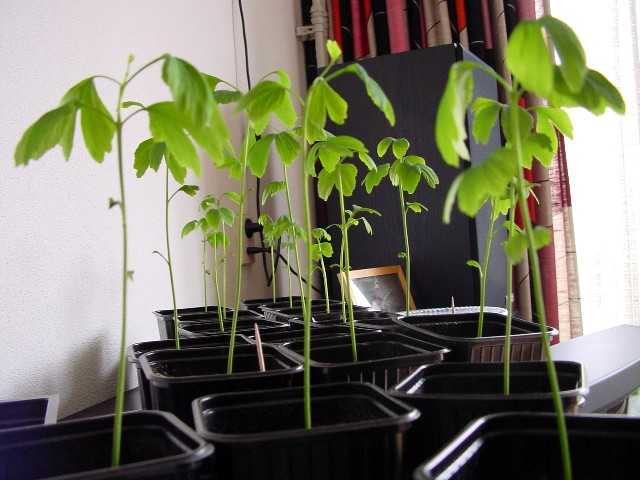
Ginkgo seedlings in their first year |
![]() In
Mexico city they grow in Chapultepec park, there are 24 ginkgoes aprox.,
and get fruit every year. In rainy years they produce lots of fruits, in
dry years less.
In
Mexico city they grow in Chapultepec park, there are 24 ginkgoes aprox.,
and get fruit every year. In rainy years they produce lots of fruits, in
dry years less.
![]() Come
early fall you can see the Chinese women with their hooks, benches, and
gloves collecting them off the ground in the Garden. My students (6th graders)
are doing a project on the gingkos and they are scouting around their neighborhood's
for more sightings. And also, as it turns out there are about 8 trees 2
blocks away from my home. One morning I noticed an Asian lady shaking the
"seeds" from the tree so I went home and got a jar and gloves to collected
some to show my students. And I have directed my students to your website
for information.
Come
early fall you can see the Chinese women with their hooks, benches, and
gloves collecting them off the ground in the Garden. My students (6th graders)
are doing a project on the gingkos and they are scouting around their neighborhood's
for more sightings. And also, as it turns out there are about 8 trees 2
blocks away from my home. One morning I noticed an Asian lady shaking the
"seeds" from the tree so I went home and got a jar and gloves to collected
some to show my students. And I have directed my students to your website
for information.
![]()
![]() There
is a small slim Ginkgo Tree at the entrance to the Park..Carl Schulz Park..home
of Gracie Mansion, New York. Not very tall..but elegant and slender. It
roots below and to the right of the street sign 86th Street and East
End Avenue.
There
is a small slim Ginkgo Tree at the entrance to the Park..Carl Schulz Park..home
of Gracie Mansion, New York. Not very tall..but elegant and slender. It
roots below and to the right of the street sign 86th Street and East
End Avenue.
It stands alone in its simplicity.
Eight feet if we're lucky. She's
doing fine....as I noticed her high branches..were bare. But the others...ahhh,
the others filled lush with full fans of dark green ginkgo leaves. I can
almost wrap my hand around her singular trunk, so slender. She seems to
have be punned twice..long ago.
Such was her beauty I wanted
just one leave for myself..but I dared not disturb her. Lucky for me..as
I was walking home..I looked down..and there on the street... one perfect
...small leaf!!
Ahhhhh the joy of it!
New York, at the intersection
of "East" 86th Street, she would be ..located: south east. First
tree, on the line of trees..planted in the pavement before entering the
park...surrounded by cobble stones.
![]() My
mom gave me a "twig" about 5 years ago and said it was a Gingko tree. I
planted it in my backyard, not really serious about it growing-I have 2
big dogs... They chewed on it , dug it up a few times and so on.
I didn't have the heart to just get rid of it, because my mom had passed
away 3 years ago, and it was a special reminder of her. (She loved gingkos.)
Well, that tree has really earned its spot in the yard !! It's now
about 10-12 feet tall !!! The leaves are beautiful. It has thrived.
The dogs no longer bother it.
My
mom gave me a "twig" about 5 years ago and said it was a Gingko tree. I
planted it in my backyard, not really serious about it growing-I have 2
big dogs... They chewed on it , dug it up a few times and so on.
I didn't have the heart to just get rid of it, because my mom had passed
away 3 years ago, and it was a special reminder of her. (She loved gingkos.)
Well, that tree has really earned its spot in the yard !! It's now
about 10-12 feet tall !!! The leaves are beautiful. It has thrived.
The dogs no longer bother it.
![]() I
would just like to add my method germinating seeds. I don't have
a 100% germination rate but I do have a 100% survival rate of the trees
that do germinate. I have two supposedly male ginkgo trees, but several
branches on the top of the crown of both trees seem to produce seeds every
year. I take these seedlings when they fall from the tree and place them
in the bucket outside on some soft earth under a pile of leaves. These
trees are located in the moist temperate regions of New York State, near
Mattituck, Long Island. The soil is rich and loamy with quite a bit
of sand in it and has good drainage.
I
would just like to add my method germinating seeds. I don't have
a 100% germination rate but I do have a 100% survival rate of the trees
that do germinate. I have two supposedly male ginkgo trees, but several
branches on the top of the crown of both trees seem to produce seeds every
year. I take these seedlings when they fall from the tree and place them
in the bucket outside on some soft earth under a pile of leaves. These
trees are located in the moist temperate regions of New York State, near
Mattituck, Long Island. The soil is rich and loamy with quite a bit
of sand in it and has good drainage.
After remaining under the leaves
for about five or six weeks the small seeds still have fruit on them, which
is shriveled and
dried. Next, I take these
seeds as is and place them in some of the rich sandy soil in another bucket
at a depth of about 2 inches. The seeds are then left outside and undisturbed
in a sunny location to winter and for nature to take it's course. Where
I live in zone 6b, germination takes place in early July, with the seeds
reaching about 1 foot tall at the end of growing season in November. The
germination rate is about 60%. In my opinion only the strongest of seedlings
can break through the the tough seed shell, which is equivalent to the
survival of the fittest for this beautiful tree.
So far, these little fighters
have survived periods of neglect when I was traveling for my job, as well
as two hurricanes, Sandy and Irene. The trees have never been staked, yet
they grow straight and true, and already they possess the lovely form of
their parents in miniature. When these seedlings reached 3 years old and
about 33 inches , they were planted in their own sunny permanent location
in my yard. Interestingly, even tho these seeds were planted together in
a large container, each little tree retained its own mass of roots, which
did not grow into the roots of its neighbors. The trees are in the ground
now for a couple of weeks, with no sign of shock from the transplantation.
The only thing I do notice is that the leaves are changing to a richer
shade of green, and the trees seem to be growing. I'm far from an expert,
but this method seems to work for me.

Read more reactions of readers in my forum:



 follow
me on Twitter
follow
me on Twitter
![]()
© Cor Kwant ![]()
Copyright information.